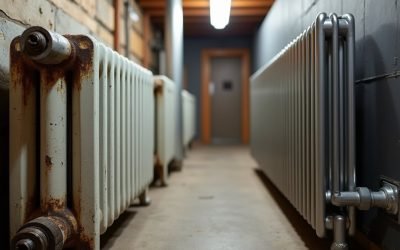You’ll typically pay between $400-$1,500 for a plumber to replace your radiator, with labor accounting for 40-60% of total costs at $200-$800. Your final bill depends on radiator type, location, and installation complexity. Basic steel units start around $150, while premium models exceed $1,000. Plumbers charge $75-$150 per hour, with urban areas costing more than rural regions. Additional expenses include valve replacements, pipe modifications, and disposal fees that can add $175-$475 to your project. Understanding these cost factors will help you make informed decisions about your heating system upgrade.
Average Cost Breakdown for Radiator Replacement
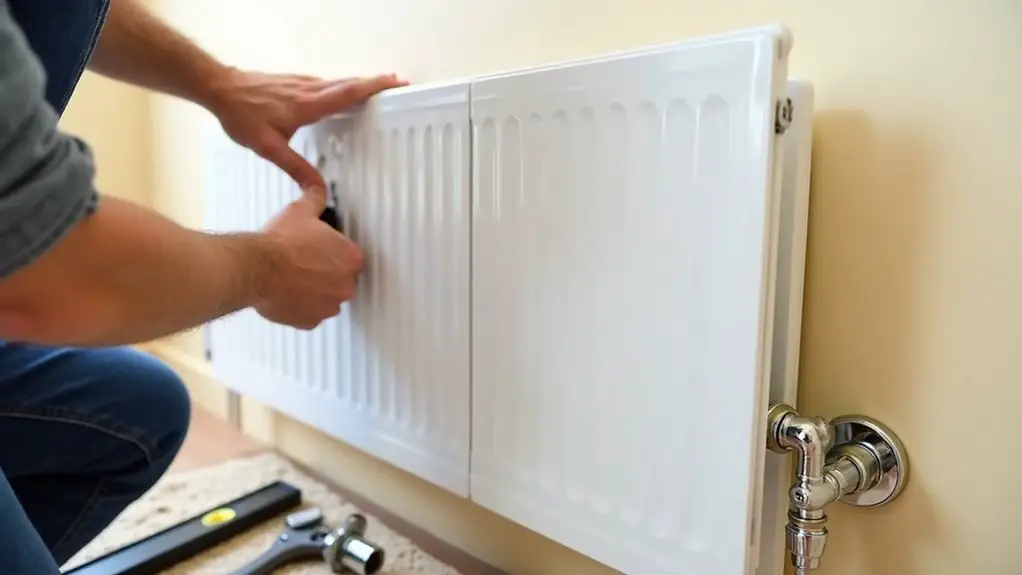
When you’re facing a radiator replacement, understanding the cost breakdown helps you budget effectively and avoid unexpected surprises.
Labor typically accounts for 40-60% of your total expense, ranging from $200-$800 depending on complexity and location. Radiator materials constitute the remaining portion, with basic steel units starting around $150, while premium cast iron or aluminum options can exceed $1,000.
Your plumber’s hourly rate, usually $75-$150, greatly impacts final pricing. Additional costs include valve replacements ($50-$100), pipe modifications ($100-$300), and disposal fees ($25-$75).
Energy efficiency upgrades, such as thermostatic valves or modern radiator designs, add $100-$400 but deliver long-term savings. Geographic location, system complexity, and seasonal demand also influence pricing variations you’ll encounter.
Factors That Influence Plumber Pricing
Several key variables determine what your plumber charges for radiator replacement, and understanding these factors empowers you to negotiate better rates and avoid overpaying.
Location greatly impacts pricing, as urban areas typically cost more than rural regions. Your radiator’s complexity affects labor time—older systems requiring specialized plumbing tools command higher rates. Accessibility matters too; cramped spaces increase installation difficulty.
Key pricing factors include:
- Radiator type and size – Cast iron costs more than standard steel models
- Pipe modifications – Existing connections may need updates
- Emergency timing – Weekend or holiday calls increase rates
- Plumber’s experience – Seasoned professionals charge premium prices
- Additional services – System flushing or radiator maintenance adds costs
Material quality choices also influence final pricing.
Discuss these variables upfront to receive accurate estimates and make informed decisions about your heating system upgrade.
Different Types of Radiators and Their Installation Costs
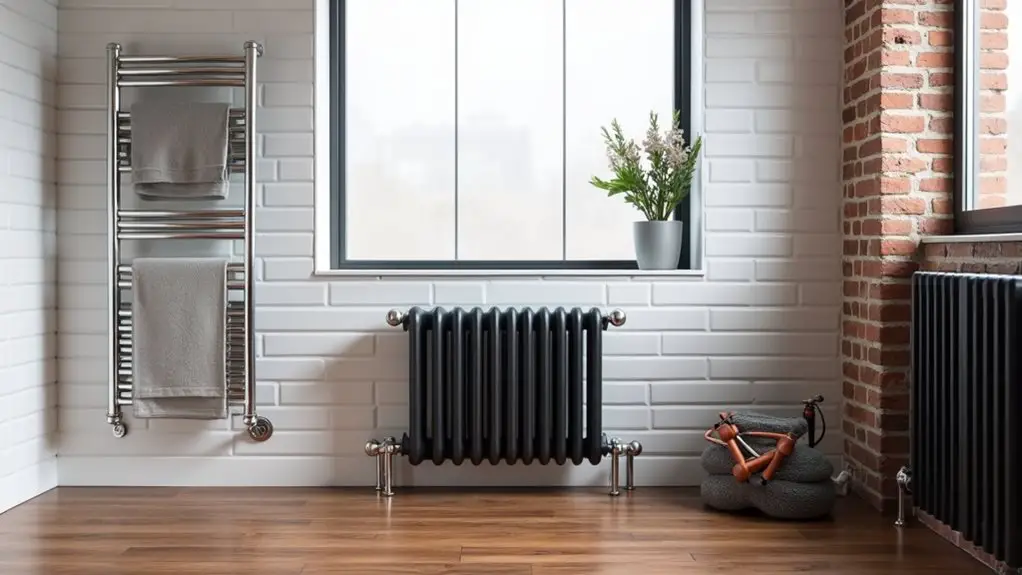
When you’re replacing your radiator, the type you choose greatly impacts both material costs and installation complexity.
Cast iron radiators, while offering excellent heat retention and classic appeal, typically require more labor-intensive installation due to their considerable weight and specialized mounting requirements.
Modern aluminum options present a lighter, more affordable alternative that’s easier for plumbers to install, though they may not provide the same long-term durability as their traditional counterparts.
Cast Iron Radiators
Although cast iron radiators represent the most expensive option among radiator types, they’re often worth the investment for homeowners seeking both superior heat retention and timeless aesthetic appeal.
The cast iron benefits include exceptional durability, lasting decades longer than modern alternatives.
However, installation challenges greatly impact your final costs:
- Weight considerations – Cast iron radiators require reinforced mounting and potentially additional structural support.
- Specialized labor – You’ll need experienced plumbers familiar with vintage heating systems.
- Custom fittings – Older connections may require adapters or complete pipe modifications.
- Extended installation time – Complex mounting procedures increase labor hours considerably.
- Higher material costs – Quality cast iron units range from $800-$2,500 before installation.
Expect total replacement costs between $1,200-$4,000, depending on size and complexity.
While expensive upfront, cast iron radiators offer unmatched longevity and heating efficiency.
Modern Aluminum Options
Modern aluminum radiators offer an attractive middle ground between budget-friendly options and premium cast iron models, delivering excellent heat output while keeping installation costs manageable.
You’ll find these modern materials provide superior energy efficiency compared to older steel units, helping reduce your long-term heating bills. Aluminum’s lightweight construction makes installation faster and easier for plumbers, potentially lowering labor costs by 15-20% versus cast iron alternatives.
Expect to pay $200-$400 per radiator unit, plus $150-$300 for professional installation. The quick heat-up time means you’ll notice improved comfort almost immediately after installation.
While aluminum radiators cool down faster than cast iron when heating stops, their responsive nature and excellent thermal conductivity make them ideal for modern heating systems with programmable thermostats.
Labor Rates by Geographic Location
Your location greatly impacts what you’ll pay for radiator replacement labor, with urban areas typically commanding higher rates than rural communities due to increased overhead costs and demand.
Regional price variations can swing dramatically across the country, where a plumber in New York City might charge double what you’d pay in rural Montana for the same installation work.
State-specific labor rates also reflect local economic conditions, union presence, and licensing requirements that directly influence your final bill.
Urban Vs Rural Costs
When you’re facing radiator replacement costs, geographic location plays a significant role in determining what you’ll pay for labor. Urban plumbing services typically command higher rates due to increased overhead costs, higher wages, and greater demand for skilled tradespeople.
The cost differences between city and country become apparent when you consider:
- Urban plumbers often charge $75-150 per hour versus rural rates of $50-100
- City contractors face higher insurance, licensing, and operating expenses
- Rural plumbing professionals may travel longer distances, adding trip charges
- Metropolitan areas have stricter building codes requiring specialized expertise
- Small-town plumbers often offer more flexible scheduling and personalized service
Rural plumbing costs might seem lower initially, but limited availability can extend project timelines.
Urban markets offer more competition, potentially driving better pricing through quotes from multiple contractors.
Regional Price Variations
Beyond the urban-rural divide, specific geographic regions across the country exhibit distinct labor rate patterns that can substantially impact your radiator replacement budget.
West Coast markets like San Francisco and Seattle typically command premium rates, often 30-40% higher than national averages due to increased living costs and stringent licensing requirements.
Meanwhile, Midwest regions generally offer more competitive pricing, with installation differences reflecting local market conditions and contractor availability.
Southern states frequently present moderate pricing structures, though major metropolitan areas like Atlanta or Miami can mirror coastal rates.
Northeast corridors, particularly around Boston and New York, maintain consistently high regional pricing due to complex building codes and union labor standards.
You’ll find that researching your specific area’s market conditions helps establish realistic budget expectations for your radiator replacement project.
State-Specific Labor Rates
Although regional trends provide helpful context, examining specific state-level labor rates reveals more precise cost expectations for your radiator replacement project.
State regulations and labor unions greatly influence plumber wages, creating distinct pricing patterns across different states. You’ll find these factors particularly impact your final bill:
- High-cost states like California, New York, and Massachusetts typically charge $80-120 per hour due to strict licensing requirements.
- Mid-range states including Texas, Florida, and Illinois average $60-85 per hour with moderate regulatory frameworks.
- Lower-cost states such as Alabama, Arkansas, and Mississippi range $45-70 per hour with less stringent regulations.
- Union presence can increase rates by 15-25% in heavily organized markets.
- State licensing fees and continuing education requirements add operational costs passed to consumers.
Understanding your state’s specific labor market helps you budget accurately for radiator replacement services.
Additional Expenses Beyond the Basic Replacement
While the base cost of radiator replacement might seem straightforward, you’ll often encounter several additional expenses that can considerably impact your final bill.
Additional materials like new valves, pipe fittings, or thermostatic radiator valves can add $50-200 to your project. You’ll also face disposal fees for removing your old radiator, typically ranging from $25-75 depending on local regulations and waste management requirements.
System modifications present another cost factor. If your new radiator requires different pipe configurations or mounting brackets, expect labor charges of $100-300. Emergency callouts during weekends or holidays can increase rates by 50-100%.
Don’t forget about potential wall repairs if mounting points differ from your previous radiator. These seemingly minor additions can transform a $400 replacement into a $800+ project, so budget accordingly.
When Extra Plumbing Work Drives Up Costs
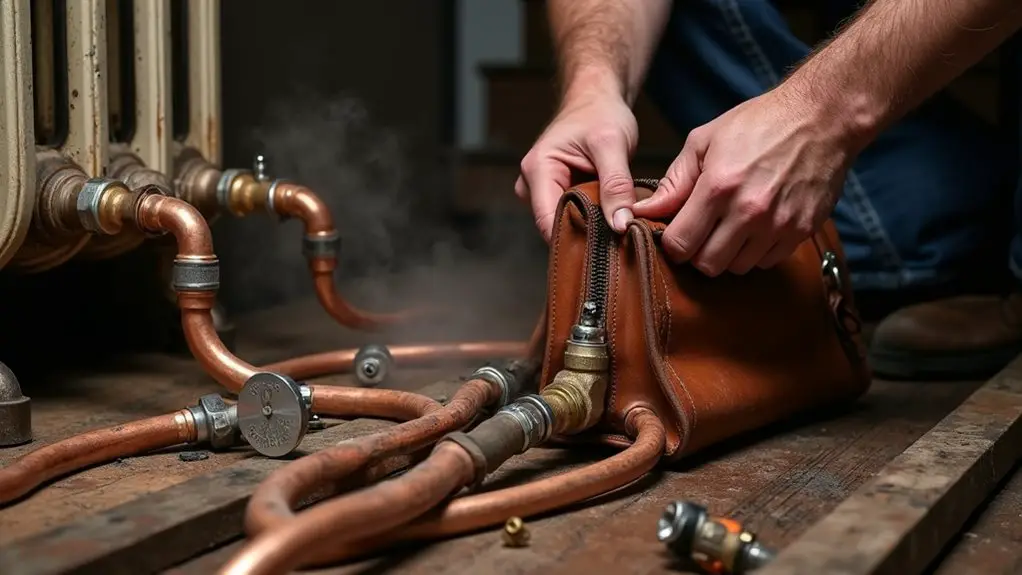
Sometimes your radiator replacement uncovers underlying plumbing issues that’ll greatly inflate your final bill.
When plumbers access your heating system, they often discover problems that weren’t visible before, turning a straightforward job into complex unexpected repairs.
These plumbing emergencies can greatly impact your budget:
- Corroded pipes requiring immediate replacement to prevent water damage
- Faulty valves that must be upgraded for proper system function
- Leaking connections demanding extensive rework of surrounding plumbing
- Outdated fittings that don’t meet current building codes
- Water pressure issues necessitating additional system modifications
You’ll face difficult decisions about addressing these problems immediately or risking future breakdowns.
Most plumbers recommend fixing discovered issues during the initial replacement since accessing the same areas later costs more in labor and potential property damage.
Getting Accurate Quotes From Multiple Contractors
How can you guarantee you’re getting the best value for your radiator replacement without falling victim to inflated pricing or hidden fees? Start by contacting at least three licensed plumbers for detailed estimates.
When requesting quotes, provide identical information about your project to ascertain fair quote comparison. Ask each contractor to itemize labor, materials, permits, and potential additional costs.
Don’t simply choose the lowest bid—evaluate contractor reliability by checking licenses, insurance, references, and online reviews.
A reputable plumber will visit your home to assess the job properly rather than providing estimates over the phone. Request written quotes that clearly outline project scope, timeline, and warranty details.
This thorough approach helps you make an informed decision while protecting yourself from unexpected expenses.
Ways to Reduce Your Overall Replacement Expenses
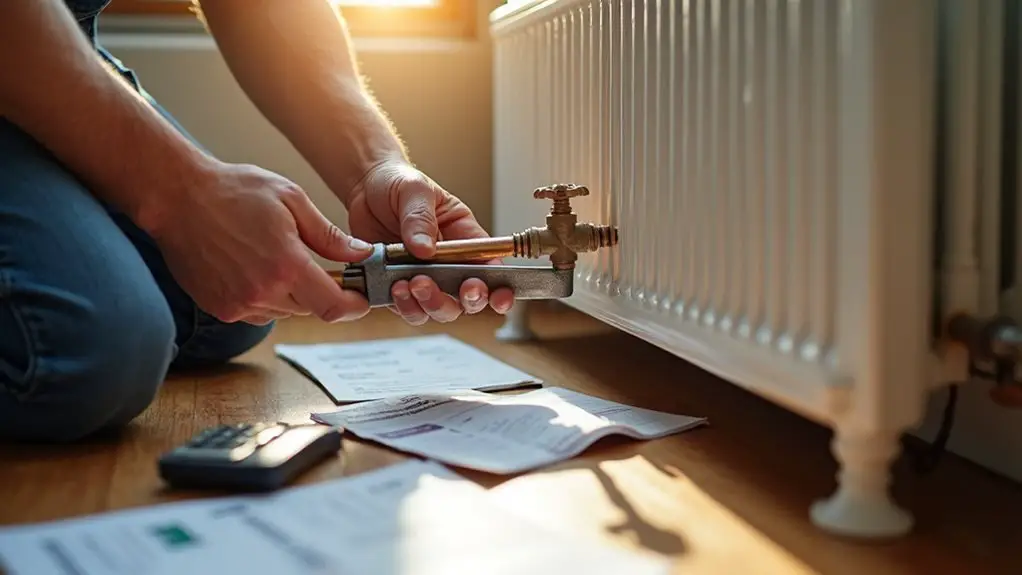
Although radiator replacement represents a major expense, several strategic approaches can substantially lower your total project costs without compromising quality.
These cost saving tips can make your project more affordable while guaranteeing professional results.
Consider these effective strategies:
- Schedule during off-peak seasons – Book your replacement during spring or summer when demand is lower.
- Bundle multiple repairs – Combine radiator work with other plumbing projects to reduce labor costs.
- Choose standard models – Select conventional radiators instead of premium or specialty units.
- Prep the workspace yourself – Clear the area and remove obstacles before the plumber arrives.
- Implement preventive maintenance practices – Regular system flushing and bleeding extends radiator lifespan.
You’ll maximize savings by getting multiple quotes and negotiating payment terms with contractors.
Signs You Need Professional Help Vs DIY Consideration
When facing radiator problems, you’ll need to carefully evaluate whether the situation requires professional expertise or falls within your DIY capabilities.
Simple tasks like bleeding radiators or adjusting thermostatic valves are manageable for most homeowners. However, complete radiator replacement involves complex plumbing connections, potential pipe modifications, and system pressure balancing that exceed typical DIY limitations.
You should call a professional when dealing with gas boilers, electrical connections, or structural modifications. Signs demanding professional expertise include water damage, unusual noises, uneven heating throughout your home, or visible corrosion around pipe joints.
Additionally, if you’re uncomfortable working with tools or lack experience with plumbing systems, professional installation guarantees safety and warranty protection.
Consider your skill level honestly—improper installation can lead to costly water damage and system failures.
Final Thoughts
Don’t let radiator replacement costs catch you off guard or break the bank. You’ve learned that prices vary considerably based on radiator type, location, and additional plumbing needs. Getting multiple quotes helps you compare options and find competitive rates. Whether you’re dealing with a simple swap or complex installation, understanding these factors puts you in control. Remember, investing in professional installation now prevents expensive headaches down the road.
- How Much Will a Plumber Charge to Replace a Radiator? - August 22, 2025
- Should I Replace 20 Year Old Radiators? - August 22, 2025
- Is Zillow Only for US Homes? - August 22, 2025
